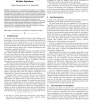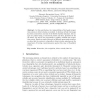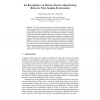101
click to vote
ICIP
2009
IEEE
14 years 10 months ago
2009
IEEE
Current iris recognition systems usually regard poor quality iris images useless since defocused or partially occluded iris images may cause false acceptance. However, such a stra...
121
Voted
PAMI
2007
15 years 1 days ago
2007
—This paper focus on noncooperative iris recognition, i.e., the capture of iris images at large distances, under less controlled lighting conditions, and without active participa...
112
click to vote
BIOID
2008
15 years 2 months ago
2008
Abstract. In this contribution, the vulnerabilities of iris-based recognition systems to direct attacks are studied. A database of fake iris images has been created from real iris ...
136
click to vote
ICB
2007
Springer
15 years 4 months ago
2007
Springer
Abstract. In state-of-the-art iris recognition systems, the input iris image has to be compared with a large number of templates in database. When the scale of iris database increa...
116
Voted
ICBA
2004
Springer
15 years 6 months ago
2004
Springer
As a reliable approach to human identification, iris recognition has received increasing attention in recent years. In the literature of iris recognition, local feature of image de...
100
click to vote
ISVC
2007
Springer
15 years 6 months ago
2007
Springer
Abstract. The iris is currently accepted as one of the most accurate traits for biometric purposes. However, for the sake of accuracy, iris recognition systems rely on good quality...
97
Voted
ICIP
2007
IEEE
15 years 6 months ago
2007
IEEE
Iris pattern is commonly regarded as a kind of phenotypic feature without relation to genes. In our previous work, we argued that iris texture is race related, and its genetic inf...



